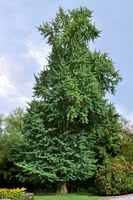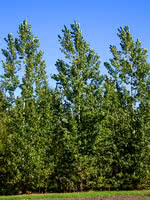Mon-Fri 9am - 5pm Mountain time
Ginkgo Biloba vs Prairie Sky Poplar
Ginkgo biloba
Populus x canadensis Prairie Sky
NOT AVAILABLE THIS SEASON - MIGHT RETURN
The Ginkgo Biloba is regarded as one of the most distinctive and beautiful of all the deciduous trees, and has remained genetically unchanged for millions of years. Its beautifully fan-shaped leaves develop a clear yellow colour in fall. Graceful and attractive year-round, Ginkgo is the perfect conversation starter in your yard.
Prairie Sky Poplar is a fast-growing columnar hybrid poplar developed at Agriculture and Agri-food Canada's Morden Research Station. It is adaptable to many soil conditions and seems to do best in the southern-most parts of the prairies.
Good as a shade or shelterbelt tree, it is often used in buffer zones as a visual screen or hedge. Ideal for lining properties, roads, etc.
Ginkgo Biloba Quick Facts
Prairie Sky Poplar Quick Facts
Toxicity: Uncooked nuts in large quantities

